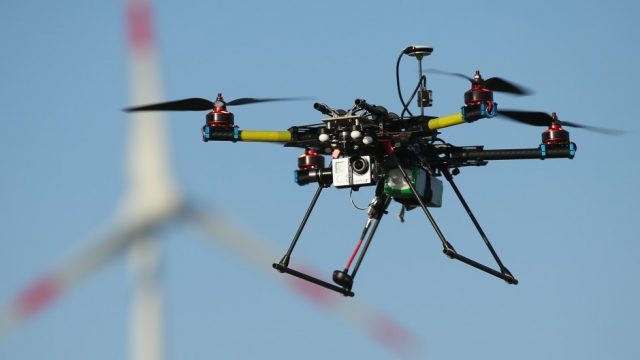North Dakota Law Enforcement Being Disingenuous About Potential For Armed Drones

Earlier this week an article by Justin Glawe, a former Grand Forks Herald reporter who now writes for many different national outlets, raised some eyebrows. Glawe’s study detailed some carefully changed wording in legislation passed earlier this year which allows law enforcement in North Dakota to put non-lethal weapons on drones.
That story has been met with consternation from law enforcement and other leaders in this state where leaders have rolled out a red carpet for the drone industry.
Drone industry publication UAS Magazine quoted Alan Frazier, deputy and chief UAS pilot with the Grand Forks County Sheriff’s Department, as being upset by the article:
To say Frazier was less than pleased with Glawe’s story would be an understatement. He saidThe Daily Beast article “is full of inaccurate information, unfounded conclusions, and quantum leaps in logic.”
In addition, Frazier said that when Grand Forks County Sheriff Bob Rost testified before the North Dakota House Judiciary Committee, the UAS use of force issue was never mentioned. That’s how controversial it was at the time.
Frazier also noted that the Grand Forks Sheriff’s Department is the only non-federal agency operating UAS in North Dakota. He quoted a section of the department’s UAS unit policy which says: “Deployment of any type of projectile, chemical agent, or electrical current weapon from a GFSD UAS is PROHIBITED.”
Frazier is also quoted by Popular Science – in an article headlined “NO, NORTH DAKOTA ISN’T OUTFITTING POLICE DRONES WITH TASERS” – noting, agian, that Sheriff’s Department policy precludes the arming of drones even with non-lethal weapons:
Alan Frazier is an associate professor of the University of North Dakota, as well as a deputy sheriff in the Unmanned Aircraft Systems Unit of the Grand Forks County Sheriff’s Department. He is one of the 15 voting members of the UAS Research Compliance Committee, and has been with the Grand Forks drone unit since its start. By email, he shared the Sheriff’s written drone unit policy, noting that the unit policy itself prohibits “deployment of any type of projectile, chemical agent, or electrical current weapon,” from a Grand Forks Sheriff’s Department unmanned aerial system. That puts tasers, pepper spray, rubber bullets, and other non-lethal weapons outside the guidelines of acceptable police use.
But here’s the problem: As Glawe noted in his original article, the language in the legislation passed earlier this year was specifically changed to allow non-lethal weapons at the request of a law enforcement lobbyist.
The bill’s stated intent was to require police to obtain a search warrant from a judge in order to use a drone to search for criminal evidence. In fact, the original draft of Rep. Rick Becker’s bill would have banned all weapons on police drones.
Then Bruce Burkett of North Dakota Peace Officer’s Association was allowed by the state house committee to amend HB 1328 and limit the prohibition only to lethal weapons. “Less than lethal” weapons like rubber bullets, pepper spray, tear gas, sound cannons, and Tasers are therefore permitted on police drones.
That the Grand Forks County Sheriff’s Department currently has a policy against any weapons, lethal or otherwise, on drones is all well and good. It still doesn’t answer the question about why a lobbyist for law enforcement specifically sought and won a loophole allowing drones to be armed.
Why would that be a priority for law enforcement in the state if they didn’t, at some point, plan on pushing to arm drones?
This is what I’ve struggled with throughout this debate over drones. When people have brought to the forefront questions about how drones will integrate into our society – what do they mean for privacy and law enforcement and, yes, even weapons – the answer from law enforcement and the pro-drone economic development community has largely been “shut up, who cares.”
That’s unfortunate.
I’m not against drones. Heck, I’m not even necessarily against law enforcement using drones. But I wish many of our leaders both in and out of the law enforcement community were a little more circumspect about what the embrace of drones might mean for our society.




